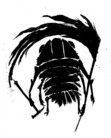Patrick Stuart's Blog, page 14
June 29, 2022
I Played King of Dragon Pass
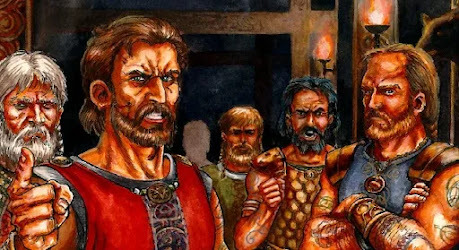 Piss off your Weaponthanes and they start doing interviews on Fox News about the lack of national defence
Piss off your Weaponthanes and they start doing interviews on Fox News about the lack of national defenceMETA GAME ELEMENTS
There is no save game and no multiple simultaneous paths, whatever game you are in you are IN and there is no going back from any choice or looking to another causality stream to see what you could have done - unless you want to quit and tank every decision made up until this point.
There are indeterminate responses to God quests based presumably on lots of stuff happening behind the scenes like the religion of the quester but it looks also like the religious nature of the tribe and what temples etc, also whether you have been raiding or whatever.
The interrelationship between invisible numbers, limited knowledge and the will of the gods is the most interesting element.
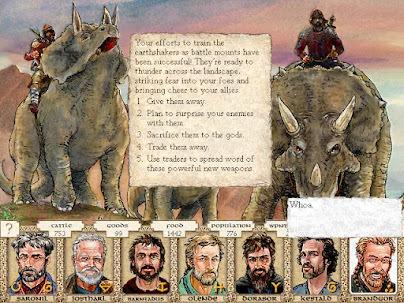 I never got to ride Dinosaurs & feel personally betrayed by this
I never got to ride Dinosaurs & feel personally betrayed by thisGUNS AND BUTTER
There are two kinds of raids;
cattle raids - which require stealth and basically theft, and Raid raids which can vary hugely from armed demonstrations to theft with force to, in theory - genocide and repossession of land.
Intra-culture raiding is considered normative and in fact a complete lack of raiding at any time is considered a bit weird will lose you respect and the happiness of your warrior class.
A primal human problem; you need warriors to defend the farmers or other warriors will come and take stuff, and you need farmers to feed the warriors. But the two are in endless conflict, pissed off with each other at least half of the time and annoyed about the others privileges - or lack of their own.
(And holy fuck are farmers conservative. They do NOT like outsiders and are very happy to be dicks based on ancient cultural stuff despite the fact that its you the leader who has to deal with the problems that result.
Cattle are the 'points' of the game so everyone always wants more cows.
The best way to get cows is cattle raid or full raid, (plus you need to raid and to be seen raiding to be a 'proper' clan both within and without). No raids and your weaponthanes get upset, no raids and others start to think you are a pussy and your diplomacy weakens.
However, you are surrounded by neighbours. These are also the easiest and lowest risk people to raid. BUT - if you can make allies of them then they are also your best partners, can protect you from other raiders with warnings, set up short trade networks and can ultimately help form your tribe which is the route to 'winning' the game.
As always and forever it seems in all human cultures outright setting out to be purely and entirely peaceful just fucks you over while going full-military fucks you in a different way.
You can go the full-military war clan route (haven't tried it myself), and basically be Sparta with wars and super-slavery but the more you raid the more potential allies you lose. So I would imagine that if you are going to rule others through military force you better be very VERY strong all of the time.
Enemies - feuds, are a big long-term drain on your resources and constant threat, however, they can also be useful as with a feud, you at least know who you are raiding next time. So the next time your warrior class wants a fight you can just say oh yeah we can go raid the blue ox clan like last time and from the point of view of internal clan politics it doesn't really matter if you win or lose, so long as you don't lose too badly. If you win the Thanes are happy and if you lose it was their own fault for raiding and there are presumably less of them to support.
There are also random events which crop up which can sometimes result in weird or supernatural problems which need to be sent "elsewhere". So in those cases you can say "ok send the spirits to the blue ox clan".
Ultimately, if you want peace, stability and continuity you actually need enemies, or at least one enemy, roughly your strength, hopefully a bit weaker but still a threat, a medium distance away so it’s you are not a continuous threat to each other but can still reach each other. The most stable, and ultimately peaceful option is to just have a continuous low-intensity conflict with the same tiny group, without anything really changing.
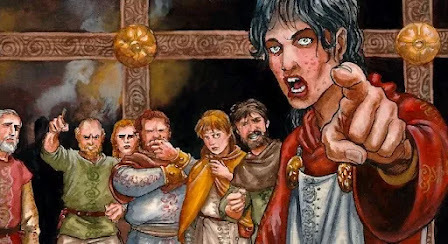
WOMEN
The game pretty decent iron age simulator where you can choose whether or not to keep slaves and can possibly even build a slave empire and can engage in human sacrifice, and even mass human sacrifice, as well as raiding and plundering other clans, but still has the normative fantasy standard of combat skills and political power being evenly distributed between men and women, which, if it comes to political power is not impossible as small societies can have huge cultural diversity and lots of variety in iron age cultures, but pretty sure the Indo-European groups were v patriarchal.
Not complaining, it’s just an interesting look at our particular cultural moment where yes you can build a slavery simulator but it has to have a gender balance.
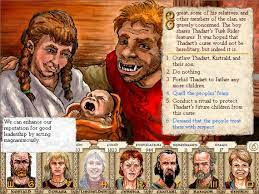
THE PERSONALITY OF A BUNCH OF NUMBERS
Truly the human mind is extremely based because a portrait, some auto generated text speech and a bunch of semi-random numbers do indeed become 'people', especially for my clan leaders, the first of the council and usually the first face you click on to get advice on stuff.
My first leader was kind of a hyper competent technocrat, a female worshipper of Issiaries, the talking god and the clan itself were quite non-normative, and worshipped Almal the sun god. We didn't even have a temple to Orlanth, the main god of our culture group. I really liked her because she always gave clear and detailed advice, consistently crushed trading and diplomatic issues, and our clan got really good at trading so in many ways the best person for the job.
But the clan, or perhaps the game, or the structures of culture the game was simulating, didn't like her, and while most of her explicit missions worked out and she was good at most individual things, the clan itself laboured; short on resources and cows, low status and ultimately disbanded.
For my second try I went with a very normative Orlanthi clan who made all the normal choices and the leader was a very normal male Orlanth worshipper with ok stats and was frankly something of a midwit mediocrity giving banal or empty advice regardless of circumstance.
I honestly really didn't like the guy and in most of his crises found him to be a very basic, even poor, leader but the clan flourished, a normative Orlanthi leading a normative clan with a nice big temple to Orlanth in the middle. Not exceptionally great at any particular thing but doing quite well on everything. Eventually we formed a tribe - but he got cucked out of the tribal leader role and we were stuck waiting for people to die and still couldn't get him in and eventually I got bored.
Third try was basically classic old woman feminist leader in a peaceful tribe dedicated to the mother goddess. Our main objective was to sit there and grow, which indeed we did in our increasingly fortified steading. Never had food problems, still couldn’t get population up much and no one really liked us, but fuck it otherwise things were fine. But it felt like game was becoming static and I am again a bit bored.
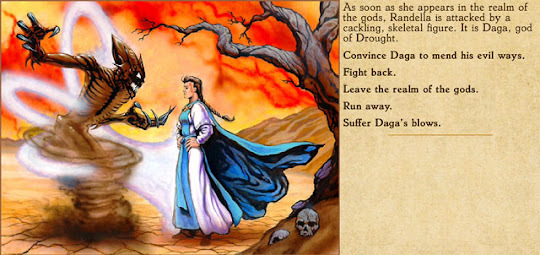 The "correct" answer is "suffer the blows" but this might get your Quester killed...
The "correct" answer is "suffer the blows" but this might get your Quester killed...RELIGION AS TECHNLOLGY
Actually it’s pretty substantially different in a lot of ways, but in terms of dedicating resources to 'researching' things to provide improvements, its somewhat similar.
You can sacrifice to a range of gods to find out more about them, (it's never explicitly clear which sacrifices, or how many or how much will be needed for each god). In my first game I actually sacrificed a human to the cow goddess and she got so fucked off someone in my ruling council left the tribe in disgust, also never sacrifice cows if you don't have to, just sacrifice goods.
From these sacrifices you can learn 'mysteries' which are either something like blessings or lore you can use to do ritual magic.
With enough knowledge of blessings from a god you can build a shrine which can be expanded to a temple or a big temple. This is basically a resource exchange as for regular resource loss you get an 'always on' blessing which affects your whole clan. Or you can sacrifice for individual blessingswhich can cost more but isn't a yearly tax (but also might not work sometimes), and as you get more fragments of myth you can do Heroquests which is form of clan wide magic where you re-enact elements of myth to get real magical effects.
If you fuck it up you get a BEATING; big magic loss, loss of reputation and maybe the quester and others physically wounded pluss WILD MAGIC - I fucked up a quest from the talking god and all of the maps for everyone in the area were FUCKED for years and all of my exploreres I sent out died. I dang well broke reality with my bullshit and people never let me hear the end of it.
It’s the lack of knowledge, indeterminacy or results and unseen interrelationship with your clan structure that really makes this interesting in-play.
Each Hero-Quest is a multiple choice adventure and over time, through reading lore or through cheating, you can learn the 'optimal' choices but the choices are not always equally weighted, and do not always respond the same way.
There are a few things you know about. The quester being a worshipper of the right god can help, having one clan council member from different gods each can help.
(That can be a challenge because very normative clans are often not very diverse in their makeup (as pertains to worshippers)
The two 'normative' clans I ran, the Orlanthi and the Mother Goddess clan, had shitloads of the normative gods but if I wanted someone on the council from some less regular god, either I couldn't get them or I had to settle for someone with mediocre stats in order to fill the post - goddman diversity.
Whereas the somewhat odd clan I started with had a bunch of wild and whacky members - so diversity of worship was never a problem - but the clan itself felt less 'cohesive' and the things it was good at never synergised as much across domains (though it was also my first try).)
(also its a nice point that its always good to have one worshipper of the trickster god on your council - in some special events they can generate alternative solutions to problems; tricking a hungry ghost with a trail of food, tricking a dragon out of its gold, being an expendable council member when shit hits the fan, but they never really cause enough trouble *in* the clan for it to feel like an interesting choice having them on the team - its more like marvel Loki than myth Loki)
Beneath all that, does your clan 'feel' right? Are you Orlanthi, with a big Orlath temple, Orlanth-worshipping leader and do you 'act' like normative orlanthi?
Which numbers, precisely, is the game looking at to make these questions work? you don't know and that lack of knowledge makes things both frustrating and interesting?
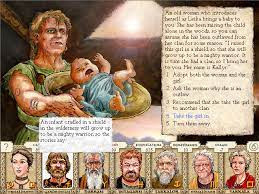 This was a really cool choice to make the first time, less so the third time.
This was a really cool choice to make the first time, less so the third time.POSSESSION IN GAMES
in almost every case when creating a true sense of possession, or a feel that you are really making choices as this entity in an imagine world there must be some combination of stable known rules and the unknown - yet an unknown not without reason.
If the game is pure known-rules and you can predict and weight how everything works - then it is merely a game and you end up just shuffling numbers.
If truly chaotic, the negative bad DM stories - where there is no stability or learnable rules - then its just a contest of personalities or wills or nothing at all.
There is some subtle synthesis between known rules, unknown rules and pure chaos (along with everything else) that tilts a system towards feeling 'real' - were you go from 'how do I maximise my sacrifices to Orlanth' to feeling like a clan leader thinking 'o fuck I hope Orlanth is ok with us this year'.
You are doing similar things in both cases but the difference is subtle. You are still making a die roll but it doesn’t feel like you are rolling the dice but like you are facing the gods.
June 23, 2022
We need to be churning more oceans!

We need to be churning more oceans! We need to be fisting more demons! We need to be killing more sons! We need to be hurling more weapons!
Part three of a short series about the elements of Proto Indo-European Mythology that haven't made it into the fantasy noosphere, or haven't made it as much as one would think, or have made it quite a lot but still a look at the reconstructed "originals" can be illuminating.
WE NEED TO BE CHURNING MORE OCEANS
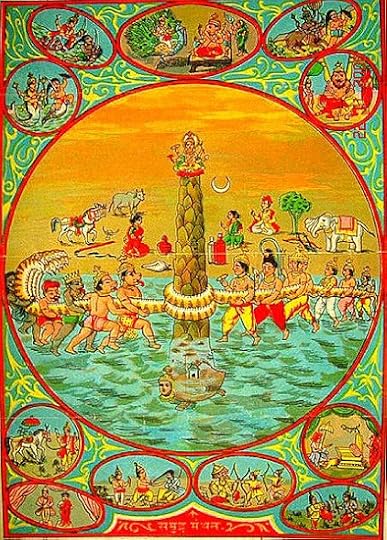
"Although the concept of elevation through intoxicating drink is a nearly universal motif, a Proto-Indo-European myth of the "cycle of the mead", originally proposed by Georges Dumézil and further developed by Jarich G. Oosten (1985), is based on the comparison of Indic and Norse mythologies. In both traditions, gods and demons must cooperate to find a sacred drink providing immortal life. The magical beverage is prepared from the sea, and a serpent (Vāsuki or Jörmungandr) is involved in the quest. The gods and demons eventually fight over the magical potion and the former, ultimately victorious, deprive their enemy of the elixir of life."
Already something of a failure because this concerns not an element of PIE Myth that hasn't been covered by the Genres but one that fits almost too-well into D&D specifically.
Elixirs and potions are happily set within the D&D cosmology so the idea of a super, super super divine level potion fits right in. After all if you can make a potion of this or that of various strength and effectiveness then why not have there be a potion of immortality which made the deathless gods what they are? And a highly interpretable boundary between powerful mortals and gods is something D&D handles pretty well.
I can imagine a 'potion of ageless immortality' being a super-high-level item, combine it with a potion of eternal regeneration and boom, you've got yourself a god.
BUT, one element that’s missing is the potions cosmological nature; it’s not just some potion that came from wherever - it was made through the combined efforts of a super-serpent, plus the beings we now call gods, plus the beings we now call demons - they made it together through some incredible process that neither group could have done alone.
And then the gods stole it, or tricked the Demons into not drinking it, and that’s where 'Gods' and 'Demons' come from, the trickers and the tricked.
Gods as original adventurers indeed.
Of course if we view this from inside the resulting mythos then the Demons were very bad and the Gods HAD to do what they did - BUT THEY WOULD SAY THAT WOULND'T THEY??? Reading back the difference between what would be gods and what would be demons looks more like the difference between two street gangs
What does it mean, or what would it mean in an imagined world, this war between the deathless trickers and the, not-quite-mortal, but definitely not deathless or ageless, tricked?
While the sacrifice myth gave the roots of reality as a kind of annihilation of self/twin, the churning elixir myth gives the roots of divine order as a kind of scam, in which we applaud the scammers because they were more clever and because they were/are sort-of on our side, or at least more on our side than whatever 'Demons' are.
The benefits of this crime being an escape into deathlessness, into eternity.
I suppose the requirement of the unified action of Gods and Demons explains why they are no longer making the 'good' version of the immortality potion - that lot will never work together again. yet at the same time it suggests a way of making more; by some third party, (the adventurers or main character of the story) tricking both groups into once again churning the cosmic ocean.
WE NEED TO BE ACCIDENTALLY KILLING OUR SONS (AND POSSIBLY BURNING OUR FORTS)
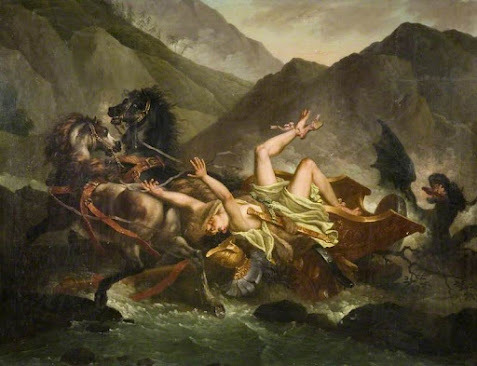
"In the Ulster Cycle, Connla, son of the Irish hero Cú Chulainn, who was raised abroad in Scotland, unknowingly confronts his father and is killed in the combat; Ilya Muromets must kill his own son, who was also raised apart, in Russian epic poems; the Germanic hero Hildebrant inadvertently kills his son Hadubrant in the Hildebrandslied; and the Iranian Rostam unknowingly confronts his son Sohrab in the eponymous epic of the Shāhnāmeh. King Arthur is forced to kill his son Mordred in battle who was raised far away on the Orkney Islands; and in greek mythology an intrigue leads the hero Theseus to kill his son Hippolytus; when the lie is finally exposed, Hippolytus is already dead.
....
According to Mallory and Adams, the legend "places limitations on the achievement of warrior prowess, isolates the hero from time by cutting off his generational extension, and also re-establishes the hero's typical adolescence by depriving him of a role (as father) in an adult world"."
It might be bad to be a PIE hero but if you are the son of a PIE hero.. run! Run for the hills! Except don’t because you will fall over and lose your memory, be raised by hill people and become their hero, try to free them from the tyranny of the river-valley lord and fight him in single combat only to die and fall over again, mooning him, revealing the birth mark on your arse that confirm that yes, he just killed another son, sky-father damn it!
A key point for us is that killing the son, in Indo-European terms, is like 'killing the parents' in children’s fiction; it enables the adventure.
Sane parents stop their children going on adventures so for the story, or game, to happen, and for the Hero to happen, they need to be missing, powerless, incompetent or dead. (Like most Disney parents).
Likewise the D&D adventurer will ultimately 'age out', (though in practice they remain near-psychotic self-driven loners in otherwise communal societies), but if they were real they would probably gain families and embed themselves in a socio-political milieux, as people tend to do as they age.
How then may they adventure? You can do socio-political court dramas, but how can they meat-and-potatoes, risk-and-exploration adventure?
Clearly by accidently killing their son and/or heir in tragic and fated circumstances, this then ending their 'family line' (assuming a patriarchal society) this disconnects them from the world of line-building, politics and embedded power structures - a good time then to go on a grief-stricken old guy adventure.
How to do this with an entire adventuring party? Simply have them ALL accidentally kill each others children in the same fated event and/or situation. It’s an utterly batshit idea but not that much more batshit than the sheer number of accidental son-murders in the Eurasian mythos.
Alternate versions could be the accidental but fated self-destruction of whatever it was the adventurers invested in that bound them to society - a fort, wizards college, thieves guild or whatever.
WE NEED TO BE FISTING MORE DEMONS WE NEED TO BE BINDING THINGS MORE IMPOSSIBLY!
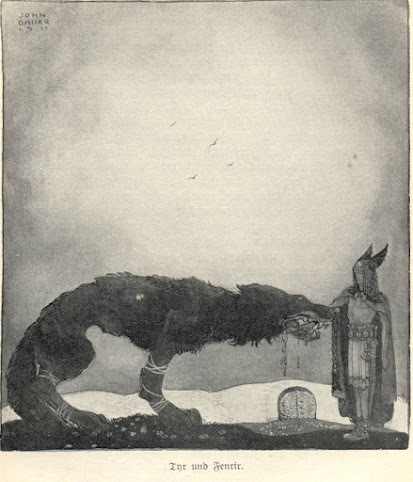 I am sorry I could not find any examples of Jamshid fisting Ahriman, I feel as if I have let you down
I am sorry I could not find any examples of Jamshid fisting Ahriman, I feel as if I have let you down"In both accounts, an authority figure forces the evil entity into submission by inserting his hand into the being's orifice (in Fenrir's case the mouth, in Ahriman's the anus) and losing it"
Firstly people aren't being swallowed by monsters enough, instead of just killed.
Secondly the idea of immobilising a way too high level being by SHOVING your hand UP INSIDE IT (an ex-friend once told me if I was bitten by a Pitbull, "just shove your finger up its arse and it will let go", I never had a chance to try it out), allowing the creature to be bound or the victim extracted.
Then - disastrously but perhaps predictably, it goes (slightly) wrong, resulting in the loss of only one hand. This feels like a good and appropriate mythic level beginning for a low level hero, a level-one adventure even. You get a major win over a too-high-level foe but at the cost of a major sacrifice and a big name-imbuing mythic incident to start of your career.
"leprosy hand guy who bound that monster that time"
"stank hand who fisted a demon and trapped it"
Combine this with the arrival of a fated weapon, with some truly exciting powers but probably also a doom (almost certainly involving killing your own son by mistake), and you have a very nice set up for a P.I.E hero - one hand, magic mace or sword, binder of monsters, fated doom.
Furthermore, investigation of the binding of Fenris myth (where Tyr got his hand bitten off), lead me to another mythic fragment;
"The Gods had attempted to bind Fenrir twice before with huge chains of metal, but Fenrir was able to break free both times. Therefore, they commissioned the dwarves to forge a chain that was impossible to break. To create a chain to achieve the impossible, the dwarves fashioned the chain out of six supposedly impossible things:
The sound of a cat's footfallThe beard of a womanThe roots of a mountainThe sinews of a bearThe breath of a fishThe spittle of a bird
Therefore, even though Gleipnir is as thin as a silken ribbon, it is stronger than any iron chain. It was forged by the dwarves in their underground realm of Niðavellir."
And this reminded me of a half-memory of something from Hinduism which I remembered as being a hero binding a demon with sea-foam. I searched for this for literally minutes and found that actually it was Indra, and not binding but a weapon;
"In the epic, there is a very brief description about the story of Namuchi and Indra. According to the story, once Namuchi hid himself in the rays of Surya due to fear of Indra.
Indra then promised him that he will not kill him in day or night, or with any weapon which is wet or dry. However on a foggy day, Indra chopped off Namuchi's head using foam of water.
From that day onwards, Namuchi's head followed Indra reminding him that he was killer of a friend. Indra then went to Brahma to find solution for this problem.
Brahma told him to bathe in the holy water of Aruna river which was purified due to confluence of river Saraswati. Indra then did the same and got rid of this sin."
The concept and gameability of the impossible binding is not something I remember seeing much in fiction or games. (It feels familiar, but, like with early wizards towers, when I look in my memory for specific examples I can't find much).
This also seems like it would be a good fit for D&D, for the 'paradox binding/assembly' the collect-these-impossible-things is essentially a fetch quest which could range from very high magic to cunning folk trickery depending on how you approached it. For the sea-foam equivalent impossible natural binding, you need to find a wonder-worker, or super-smith (who probably stole their powers from a devil or demon, that’s another possible PIE myth), who can bash together the wind and rain or whatever it is you need to make your thing.
I am interested if anyone in the comments has any other versions of the impossible binding motif or ideas about how it could be used.
WE NEED TO BE HURLING OUR WEAPONS INTO THE SEA
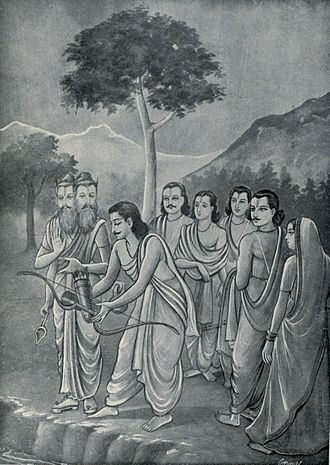
"In the Ossetic Nart saga, the sword of Batradz is dragged into the sea after his death, and the British King Arthur throws his legendary sword Excalibur back into the lake from which it initially came. The Indic Arjuna is also instructed to throw his bow Gandiva into the sea at the end of his career, and weapons were frequently thrown into lakes, rivers or bogs as a form of prestige offering in Bronze and Iron Age Europe."
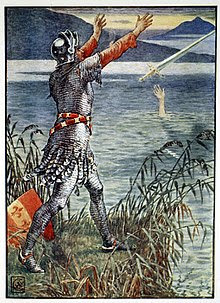
More magical weapons should be loaners imho, you get access to them by completing a quest, or by fulfilling some other strange circumstance, and get to keep them till thy work is done - this also means you can have more hot babes levitating and emerging from water. Probably the clear reflective water is a gate to the Otherworld and as somewhat god-imbued things, many weapons both come from and return to that place.
In-game the fact that it’s a 'loaner' limits the PCs freedom, but hopefully in a specific and self-selected way so that it’s still interesting.
The question of when to 'throw back' the sword, in game, is interesting. In legend it seems to happen around the point of death; the heroes whole life was the mission and it wasn't just one thing, like "kill this dragon/monster" but a more-grand 'restoration of order' deal, like with Arthur, or Arjunas taking part in the Kurukshettra.
The quest of disposing or returning the magic weapon of a hero, (without using it), is an interesting one, and the idea of the heroes super-weapon turning into an adhesive cursed weapon if it is kept too long or mis-used.
And of a PC being given a way too powerful weapon at the start of their career, which they have to 'grow into' and which they can only keep so long as they fulfil its purpose, which will also lead them to some sort of doom
really every magical weapon above a certain level should have a specific end that it has to have once it has fulfilled its purpose
"Reflexes of an ancestral cult of the magical sword have been proposed in the legends of Excalibur and Durandal (the weapon of Roland, said to have been forged by the mythical Wayland the Smith). Among North Iranians, Herodotus described the Scythian practice of worshiping swords as manifestations of "Ares" in the 5th century BC, and Ammianus Marcellinus depicted the Alanic custom of thrusting swords into the earth and worshiping them as "Mars" in the 4th century AD."
Should our heroes be worshipping their swords? If they all have a bit of the war-god, or death, the Twin, inside them, and if they are related to the Otherworld and made by the power of the Smith who tricked the Devil, then are they not themselves sacred things? And is shoving one into the Earth-Mother then not essentially making a kind of shrine? A sword is after all a kind of boundary between this world and the Otherworld, opening the gate between here and there, it surface shining just like the lake you will one day throw it into.
June 14, 2022
Murder at the Dawn of Time
"as the result of the original dismemberment of Yemo: his flesh usually becomes the earth, his hair grass, his bone yields stone, his blood water, his eyes the sun, his mind the moon, his brain the clouds, his breath the wind, and his head the heavens."
Probably you are so familiar with this concept from mythology that you haven't stopped to think about how utterly strange it is. But to go a bit deeper;
You are moving though a void, a placeless place
"neither non-being was nor being was at that time; there was not the air, nor the heaven beyond it... Neither death was nor the immortal then, nor was there the mark of night and day...".
You are not alive for nothing has ever lived nor are you dead, for nothing yet has ever l died. Neither are you immortal, like the gods, for there are none.
You simply are. Yet you are not alone for beside you is another. They are blood of your blood. A brother. Often they are the only other thing. (Sometimes there is a third and also a cow, but we will get to that later). Sometimes they are a giant, sometimes an hermaphrodite or multi-gendered being, but the one they they always are is your twin. Their name in fact is 'twin'. Yours is 'Man'.
Amidst this absolute nullity you turn on your twin, your other self, the only other thing there is, and you kill them. Then you cut them open, or since there is nothing to cut with perhaps you tear them open, and you reach into their body, steaming with blood, which is creation, and you butcher them, pulling out organs, bones, blood, tendons, hair, eyes, brain. And you cast or place these things into the nothingness and now instead of nothing there is reality. Earth, sky, sea, air, sun, moon, stars, grass and animals, all of this is built or formed from the flesh of your slain twin. And amongst all this you walk, the first man, who is also the first priest, for you made the first sacrifice and that is the nature of a priest, amidst a reality made from the corpse-flesh of you dead twin.
Of all the world creation myths, this one might be the most insanely fucked up, its also a common root or tributary concept for a bunch of cultures across the Indo-European range. For the Norse the twin was Ymir, father of giants. The Romans likely historicised their own version into Romulus and Remus, and the first romans considered themselves Remans, children of Remus, not of Romulus. In the Vedic and Persian versions the twin is Yemno, another derivative of 'Twin', and becomes the lord of the underworld, first to die and god of the dead. The killer is Manu and yes it does look like we named the species after this one guy.
"The association of Mánu with the ritual of sacrifice is so strong that those who do not sacrifice are named amanuṣāḥ, which means 'not belonging to Mánu', 'unlike Mánu', or 'inhuman'."
I think about how terrible it must be to kill your brother, the only other person who exists, the only person who can truly recognise you, and then to walk through a cosmos made of their sacrificed flesh.
It makes sense if you imagine a herding people where cattle are wealth and the most valuable and immediate source of survival. Cutting open an animal on the empty steppe, its blood steaming in the air while the butcher spreads out the parts on the hide and hands this part and that to this or that kin. Truly life through sacrifice.
Variations;
There is a third guy there, and possibly also a cow. At some point the cow gets stolen and the third guy goes and steals it back. Honestly it sounds better in the original versions.
The ritual cow stealing seems to be a restoration of order motif and the third guy is the first Warrior, with the Cow sometimes symbolising the peasant or 'grower'.
So now we have a traditional proto Indo-Euopean tripartite division of Priests/Warriors/Peasants, or if we are feeling funky, Kings (Yemno was the first king)/Priests/ Warriors/Peasants.
Sometimes 'Twin' is multi-gendered or you both are, or you are somehow the same being;
"Some scholars have proposed that the primeval being Yemo was depicted as a two-fold hermaphrodite rather than a twin brother of Manu, both forming indeed a pair of complementary beings entwined together. The Germanic names Ymir and Tuisto were understood as twin, bisexual or hermaphrodite, and some myths give a sister to the Vedic Yama, also called Twin and with whom incest is discussed. In this interpretation, the primordial being may have self-sacrificed, or have been divided in two, a male half and a female half, embodying a prototypal separation of the sexes."
WHAT CAN WE DRAW FROM ALL THIS?
Its all quite familiar from mythology, or from the mythology of fantasy. There are probably hundreds of fantasy paracosms which begin with some binary separation between different opposites.
Quite a lot of deep viscerality has been lost and we never get to see this from the first person perspective.
Viscerailty;
its quite different if you think deeply about what it would actually be like to physically destroy your own twin, your own blood, the only thing that is like you and that can know you as totally as you know them.
And to think about the blood and the guts of the matter. The butchered body cooling on the steppe, everything around you being made of the body of the sacrificed twin. Imagine what it would be like to fully believe that as your cosmic mythology - every time you look at any material thing, you are looking at the flesh of some unknowable corpse, to which you are distantly related. An uncle long removed.
Man is the first Killer and Killing is creation.
and what does it say about a culture that this primal violence lies close to its root, or what does it say about this primal self-destroying, bloody violence and butchery that it can help to form a culture that goes on to influence so much
its a pretty powerful and irresolvable moral maelstrom
The only part of current culture which I'm familiar with which deals with butchery, and especially the sacrifice and butchery of humans, is serial killer fiction
specifically one of the first things that came to mind was From Hell, the very upsetting scene where we watch Jack the Ripper take the body of his victim apart and lay out the pieces in ritual formation while mumbling and going mad/embarking on an act of ritual magic which allows him to walk though the walls of reality
of course, if all creation is made of sacrifice, then any such sacrifice is an act of sub-creation, and it makes sense that it would act as a kind of spell or prayer - altering or sustaining reality depending on perception
Manu as a Character;
We have a shitload, really an epically insane shitload of Storm Gods, Sky Gods, Sky Fathers and their derivatives, and even more, truly a cornucopia of 'Strikers', the thunderbolt wielding hero who goes around killing monsters, releasing the waters etc.
I don't think I've ever seen a story where the Manu figure, the first Priest and the first Sacrificer, who made the world from the body of 'Twin', is even in the story, let alone the main character.
What would that story even be like? Or that game?
Being the first Priest in a reality which you essentially part-created with the flesh of your Twin and teaching all these.. descendants? The children of Manu? Made up partly of your seed and partly of the flesh of Yemno, all about the Truth of Sacrifice and how Lord Yama, who takes the souls of the Dead in his place beyond the Canine Guardian and the River, is actually kind of the spirit(?) of your Twin, whose body made Reality and you also small man.
(I'm still kind of tripping that we didn't change the name of the species in all that time. Must be one of those Querty-Keyboard situations where its just too much bother once you start.)
"Oh yeah say hello to the spirit of my twin on his throne below. You know he's the only reason you can die? He was the first one to do it, which allowed time and stuff to start. I killed him. We are walking on his guts atm actually. Anyway say Hi when you see him."
More Cattle Raids;
Seems like there should be a lot more cattle raiding in both fantasy and gaming. Its absolute bedrock for the Indo-European tradition and has carried over all the way from the steppe to a few centuries ago.
But when have I seen a D&D module or adventure or a computer game, or even a scene in a fantasy novel where "Hey we have to do a cattle raid. Partly to re-enact the core of our ancient creation myth but also just to steal cows." - NEVER. Not once.
More Sacrificing;
Neither have I seen (much) sacrifice in either games or fantasy. I will grant you there is the pretty-common evil-human sacrifice which the Heroes need to stop. That one is a classic. And bits and pieces of soothsaying from the Roman/Euro tradition, but its not common to see sacrifice as a thing which the protagonists are doing, or have to do, really want to do and consider not only normal but even sacred/magical.
As the children of Manu we really should be sacrificing more. A LOT more. Gotta get those numbers up.
If all of reality is the result of sacrificing some essential meta-being, then surely lesser sacrifices can create, or change, lesser aspects of reality? After all, butchery is genesis.
May 31, 2022
Gilding the Shadow
We seem to have accidentally/on purpose reconstructed elements of the proto Indo-European mythos in our current fantasy worlds.
It happened strangely. The tides of history rolled over cultures, avoiding some until late, preserving others. We have the Norse myths, largely textualised by Christians, the Roman myths left behind after the Empire receded. We have fragments of pseudo-celtic myth through the Arthurian stories and we have very late additions, fragments of the old pagan religion of Lithuania wiped out close to the renaissance.
And we have the 'key to all mythologies' the Indian Vedic religion, which the west largely has access to due to European empires bumping into India. And we have the Iranian stuff and a bunch of other smaller things I forgot.
But in the anglo-influenced 'western' worlds of fiction the big ones are Greece, Rome and 'Vikings'. Plust maybe a dab of King Arthur. The Greek and Roman mythos are the safe spaces to play in fiction during the Renaissance, I think the Norse comes in later and well, to cut a long story short; Mallory > Sir Walter Scott > a jewish depression baby in New York making comics about King Arthur because he saw him in movies growing up and that means he's American Culture.
Add in another major point of fissure and reconstruction in the 60s probably and bobs your uncle. Or to be more precise; Sky Father sees all, Earth Mother nourishes, the hammer/lightning wielding hero fights the serpent and releases the waters (thanks), elves or whatever come from the otherworld which might also be the land of the dead, guarded by a river and a big dog (don't forget your ferryman coins), and that land is ruled by a grim dude who might be the Sky Fathers brother, who he may have also killed to start the world, and that sacrifice was witnessed by the first priest who might kind of be the first man? His name was Manu anyway. Regardless, the world will end in a giant super-fight between an Archdemon and a another hero of some kind but before that happens remember to praise the dawn, be careful around snakes as they are immortal, respect the spirits in trees and throw your sword, or bronze axe or whatever, into a pool of water because those are also gateways to the Otherworld. Also rivers have sexy spirits in them.
All of the above paragraph are from the reconstructed Indo-European mythos (accuracy levels = unknown without time travel but fuck it), and all were essentially divided up by the inheriting and influenced cultures, who respectively went super fucking hard on different aspects, a well as altering, swapping back and forth etc.
Basically imagine that the Indo Europeans cooked a bunch of cultures a meal (probably a nightmare banquet), and then every subsequent culture started adding to and changing parts. Some cultures grew, or their own cultural influence was vast, affecting many people, though they changed a lot, others were small but relatively unchanged. Most were lost.
Then from about 1500 to 1900 a Euro-oriented culture says "Fuck this", takes every remaining fragment they can find, puts it all in a blender, mixes it and starts telling stories based on the resulting taste.
And oddly enough, a lot of fictional properties.. end up producing bizarre ghost-echo facsimiles of the original myths.
Lot of mixed metaphors there and a long explanation for what's a simple essential concept; since we are in some way vibing with the shadow of the Indo-European mythos, I would like to reach back to find a few of the less-popular fragments of the assumed original and to bring them back to gild the shadow of our stately dreams.
HORNY DAWN
What if Apollo was a hot babe who was also kinda sexually predatory? Well! By frankensteining various derivations of the Dʰuǵh₂tḗr Diwós, "Sky Daughter", child of the Sky, and merging them into one horrific glorious post-indo-european whole, we can do just that!
From the Vedas we can take the positive light-bringer elements that later got appended to Apollo in the west;
"Ushas (Vedic Sanskrit: उषस् / uṣás) is a Vedic goddess of dawn in Hinduism.[1][2] She repeatedly appears in the Rigvedic hymns, states David Kinsley, where she is "consistently identified with dawn, revealing herself with the daily coming of light to the world, driving away oppressive darkness, chasing away evil demons, rousing all life, setting all things in motion, sending everyone off to do their duties". She is the life of all living creatures, the impeller of action and breath, the foe of chaos and confusion, the auspicious arouser of cosmic and moral order called the Ṛta in Hinduism."
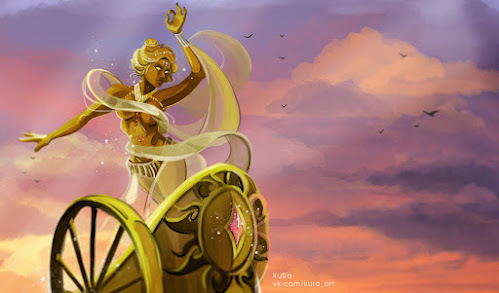 From KuRaPro
From KuRaPro"She dispels darkness, reveals treasures and truths that have been hidden, illuminates the world as it is. .... She symbolizes reality, is a marker of time and a reminder to all that "life is limited on earth". She sees everything as it is, and she is the eye of the gods, according to hymns 7.75–77."
Not only that but we can add that classic Indo-European element - COW POWER.
"Ushas is described in Vedic texts as riding in a shining chariot drawn by golden-red horses or cows, a beautiful maiden bedecked with jewels, smiling and irresistibly attractive, who brings cheer to all those who gaze upon her.
"Hymn 6.64 associates her with wealth and light, while hymn 1.92 calls her the "mother of cows" and one, who like a cow, gives to the benefit of all people."
Good so far, but there to this we can add the Greek elements of beauty;
"The dawn goddess Eos was almost always described with rosy fingers or rosy forearms as she opened the gates of heaven for the Sun to rise. In Homer,[27] her saffron-colored robe is embroidered or woven with flowers; while the singer in the Homeric Hymn to Helios calls her ῥοδόπηχυν (ACC), "rosy-armed" as does Sappho; rosy-fingered and with golden arms"
....
"The delicate and fragile beauty of her appearance seems to be in total contrast with the carnal nature that was often attributed to her in myth and literature."
Because the Greek Dawn Goddess is horny on main;
"Eos fell in love with mortal men several times, and would abduct them in similar manner to how male gods did mortal women. Her most notable mortal lover is the Trojan prince Tithonus, for whom she ensured the gift of immortality, but not eternal youth, leading to him aging without dying for an eternity. In another story, she carried off the Athenian Cephalus against his will, but eventually let him go for he ardently wished to be returned to his wife, though not before she denigrated her to him, leading to the couple parting ways."
The same energy seems to have been refracted in different cultures. Especially in the Greek/Roman mythos the original was split, order reason and hope ending up with Apollo, while irresistable beauty leads to Aphrodite, together they consume most of the original god elements leaving only a vague Dawn Goddsee behind.
But what if we had ALL OF THESE TOGETHER? We could have a super-hot golden rosy-fingered, saffron veiled Dawn riding her chariot pulled by red-gold cows across the firmament, upholding reason and order, defeating chaos, but also SUPER HOT and horny as fuck, and jealous, just abducting hot guys and not letting them go until they admit she is hotter than their wives.
THE FIRE IN WATER MYTH - THE WELL OF ETERNITY
"Another reconstructed myth is the story of the fire in the waters. It depicts a fiery divine being named *H₂epom Nepōts ('Descendant of the Waters') who dwells in waters, and whose powers must be ritually gained or controlled by a hero who is the only one able to approach it"
This one doesn't have the same "condesive" power as Sexy Dawn but it does have a particular poetic beauty which I have not seen replicated in fiction.
Fire in general is interesting in the reconstructed Indo-European mythos. 'Eternal flames' are common. The Zoroastrian seem to have inherited one part of that and in middle ages Lithuanian culture warriors for the church said it was easier to shut down the sacred eternal flames than to cut down the sacred groves as the fires gave themselves away by their brightness. Fire is also associated with sacrifice, which is a heavy, heavy strand in the mythos. Reality began with a sacrifice and the sacrifice of animals and animal flesh remains important, usually they are shared with or sent to the gods by fire, the Fire-God forming a kind of link between the mortal and divine realms.
"In one Vedic hymn Apām Napāt is described as emerging from the water, golden, and "clothed in lightning", which has been conjectured to be a reference to fire."
Nechtan of Irish Myth guarded a sacred well;
"Nechtain son of bold Labraidwhose wife was Boand, I aver;a secret well there was in his stead,from which gushed forth every kind of mysterious evil.
There was none that would look to its bottombut his two bright eyes would burst:if he should move to left or right,he would not come from it without blemish."
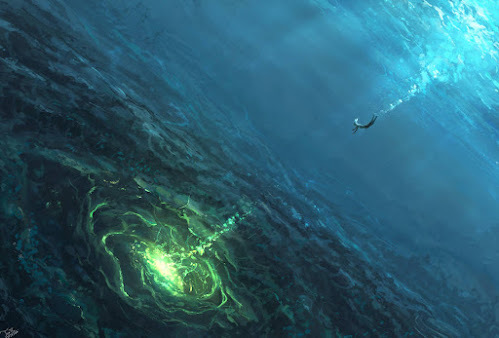 By TomTC
By TomTCAnother well from the same mythos;
"Connla's well, loud was its sound,was beneath the blue-skirted ocean:six streams, unequal in fame,rise from it, the seventh was Sinann.
The nine hazels of Crimall the sagedrop their fruits yonder under the well:they stand by the power of magic spellsunder a darksome mist of wizardry."
And from there to the numerous wells in Norse mythology. The Urðarbrunnr, the Well of Fate where the Norns go to weave the Skien of men;
Two sections of the book Skáldskaparmál reference Urðarbrunnr. The first reference is in section 49, where a fragment of a work by the 10th century skald Kormákr Ögmundarson is recited in explaining how "Odin's fire" is a kenning for a sword. The passage reads "A sword is Odin's fire, as Kormak said: Battle raged when the feeder of Grid's steed [wolf], he who waged war, advanced with ringing Gaut [Odin's] fire." and that Urðr "rose from the well."
and "Mímisbrunnr", the Well of Wisdom which seems to have a similar nature
"High explains that, beneath this root" [of Yggdrasil] "is Mímisbrunnr and that the well contains "wisdom and intelligence" and "the master of the well is called Mimir. He is full of learning because he drinks of the well from the horn Giallarhorn. All-father went there and asked for a single drink from the well, but he did not get one until he placed his eye as a pledge.""
What do we get if we condense all of these? A primal fire, perhaps that of the first sacrifice, hidden beneath water. A deep water it seems, and dark.
In many versions the three Fates (very common across the Mythos) guard or dwell nearby. In some particular animals live there, the original swans from which all others descend, or the Salmon of Wisdom, who eat the magical Hazel Nuts which drop into the water.
There is always fire or brightness under the water, a God, the flashing of Salmon, or the knowledge of Fate. Probably you are going to lose at least one eye, likely both. Odin sacrifices one to drink from the water, those who look into the well of Nechtain have their eyes melt out.
A God arises "golden, and clothed in lightning". Apām Napāt in the Vedas and also in early Zoroastrianism. Deep water, bright eternal fire, knowledge of Fate, a connection to the Divine and divine sacrifice, and the sacrifice of eyes for those who look.
Of course both Warhammer and Warcraft have their own 'Well of Eternity'. In Warhammer Tzeetch throws his chief Demon in to discover eternal knowledge and ends up with a mutated Kairos Fateweaver, who can see past and future at the same time, lies and tells the truth at once and who is curiously blind to the present.
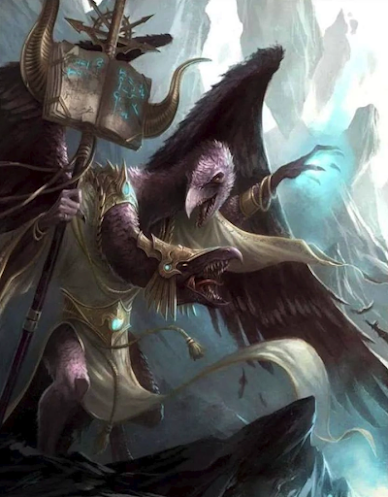
(I am out of time for this post but may return to the subject in future).
May 9, 2022
The Last Reality Boom
THE LAST REALITY BOOM
The big successful hit of this group, the one that entered pop culture, was the Matrix, but there were many more at the time
[The Acceleration]1982 - Tron
1983 - Videodrome
1990 - Total Recall
1992 - Lawnmower Man
1995 - Virtuosity
[Peak Dream]1997 - Open Your Eyes (Spanish Original)
1998 - Dark City
1999 - The Matrix
1999 - The 13th Floor
1999 - eXistenZ
2000 - The Cell
2001 - Vanilla Sky (remake of Open Your Eyes)
A slowly building acceleration of the various potential forms of the concept with a serious peak in 1999. Three films in one year about your reality being a lie, and all more similar to each other than is usual.
I somewhat loathe the morality of The Matrix, and moreso as I get older. Everyone but an enlightened few is a drone and is fine to execute them if they get in your way, because you have access to a higher reality and are trying to free them from the conspiracy. A conspiracy which is actually, at this time, keeping them alive.
And even if they are virtual, does that make it reasonable to kill them? Everyone, or nearly everyone, in the Matrix was 'real', meaning all their relationships, loves, hatreds, friendships, alliances and betrayals were 'real', even if organised in an unreal Matrix, but when it comes to killing robots and 'agents'; purely synthetic sentients, at exactly what point are you committing mind-crime? Did that weird octopus thing they EMP'd in one of the Matrix films have some digital data-kin who will be disappointed that particular squid is not coming home? Will they have a pre-saved copy who wakes up to be told "yeah we lost a previous instantiation of you, running time post this point was three years, sadly all data was lost and we don't know what destroyed them". If you are digital do you grieve for that other self?
But everything is a dream and you are being kept in that dream by those that hate you, well *you* aren't because you are one of the chosen special few who have 'woken up', but that makes it completely legitimate for you to do whatever you want to both the dreamers and their guards.
And on some level this doctrine is implicit in the 'simulated reality' genre, with its hierarchy between more-true and less-true worlds and its common themes of deception, conspiracy and subordination. There is very much a 'they' in the core 1999 films and the interests of the 'they' are in subduing, deceiving and controlling the minds of humanity, trapping them in dreams while they are somehow exploited and instrumentalised in the 'real'.
I remember questioning this a little at the time. After all, once you accept that one reality can be simulated, how can you know that any future time in which you "wake up", you have entered the 'real' reality? If one can fool you another can, and even those agents and systems may themselves be fooled.
Ultimately this leads us back to questions of morality in situations where there are multiples and layers of reality.
MANY WORLDS
By comparison, the Many-Worlds hypothesis and its pop-cultural descendants have to me a more-pleasing cosmology with a greater but harder to realise potential for moral investigation.
Harder to realise because the potential for infinite worlds actually means a lack of controlling or limiting structure and that seems to be part of the reason that the recent multiverse movies all basically default to very similar themes and emotional construction.
First stage is nihilism, with grief and pain over particular paths chosen and a general sense of meaninglessness. Then with Dr Strange and EEAaO, a general reconciliation along the lines of core pro-social values and openness to change.
Which, ok. Can't really argue with core pro-social values, and as for openness to change, well I don't like Hippies but I will accept a society of hippies over one of paranoid schizophrenic Marxists.
ISN'T THIS JUST RICK AND MORTY?
Can't confirm absolutely but feels like that show and its disturbing over-plot about nihilism and near-infinite alternate selves has had a lot of strange children.
The idea of the Multiverse is hardly new, especially for comic readers and genre heads, but *this particular* boom does seem to feed off that show, as in I feel like a lot of the creators were watching it.
Rick and Morty is very much trapped between the core nihilism and narcissism of its central premise and, I suspect, that of Dan Harmon, and the moral developments, more embedded in its structure than in any single episodes. Oddly, for a show which begins with the dominant character having the classic dark-multiverse point of view that 'everything is infinite therefore everything is both meaningless and disposable', it’s a show that refuses to throw anything away, and while realities might be disposed of, core experiences of its central cast are not, no matter how odd or surreal they are, which means it seems to grow morally, almost against its own will.
WHAT FORCES ARE THESE CHANNELING
It was easy to see the Virtual Boom feeding on a deep sense of alienation and paranoia, the separation from reality by a world of machines, but if that is the case, what weird subconscious trauma or energy is the Multiverse Boom channelling? Like the Virtual Boom many of its more notable fictions are about the sense of meaninglessness - but whereas the Virtual Boom often seemed related to a kind of anhedonia linked to isolation, disconnection and alienation through routine, the Multiverse Fictions seem to be more about shame, specifically the shame of paths not taken or relative failure compared to a desired or expected state, and to be about the meaninglessness of infinite options. In a cosmos where anything can happen and everything has happened, what does it mean that your particular events have happened? How does one find meaning in such a situation?
It feels like the current Multiverse Boom is an unconscious immune response to social media, yes, but also the psychological tension and particular kind of alienation brought about by a massively more socially interconnected world.
The Multiverse Movie character often isn't 'trapped', 'controlled' or 'kept asleep' by some evil dominating power, they are more just lost, surrounded by infinite possibilities, the full extent of which make anything they can do or have done feel utterly empty, and are living with the anger and shame of their own choices and own life-path clearly not being the best, and often not even near medium, compared to how incredible they *could* have been if they just chose differently.
This feels a lot like being connected to social media which, tbh, is a bit of a facile "vampires are syphilis" take but there we go. The SonderPain is fucking us up guys!
April 27, 2022
Pimp Post
There is something slightly useful and interesting at the bottom of the post if you want to go there BUT right now I have to pimp some RPG books I am selling off on eBay to maintain the blessed cash flow.
These are all on sale right now, auctions end on Saturday night (UK time). I will combine postage if you win multiples;
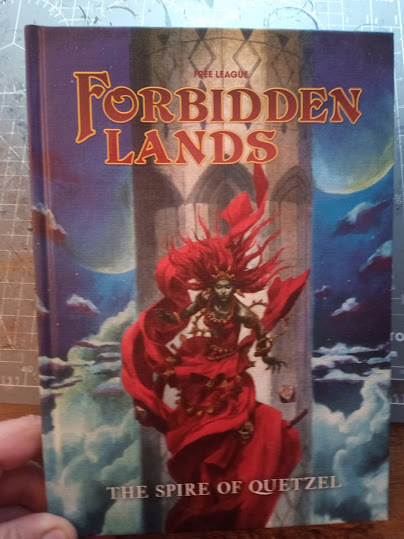
I wrote the title adventure for this and literally no-one is bidding on it. PAIN. Will sign it if you win (if thats your desire).
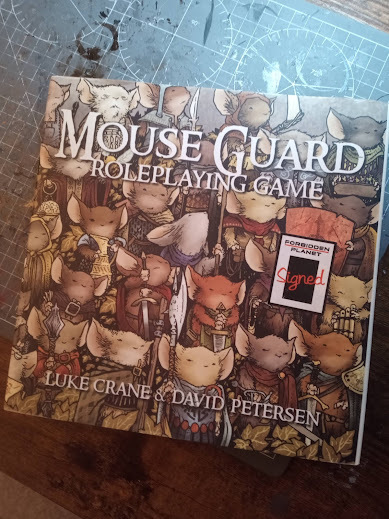
Mouse Guard! This is signed by Dave Petersen. I have never really understood this system and have just decided now to accept that I never will and will probably never run this.
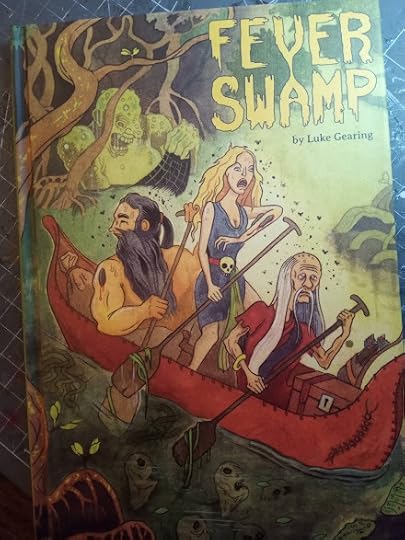
Fever Swamp! I screwed up the sale of this one last time so apologies for that.
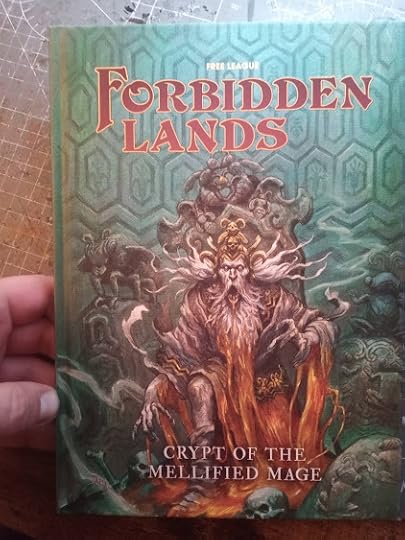
Crypt of the Mellified Mage! People seem waaaay more into this than 'Spire', paaaain. Its got Zedeck, Fiona and the robot rape guy in the period just before he got done for robot rape. Truly a cultural moment.
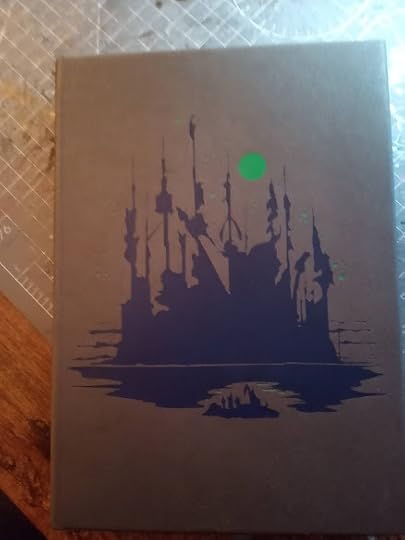
Carcosa, grab your child-strangling noose and get on board for a series of tables baby!
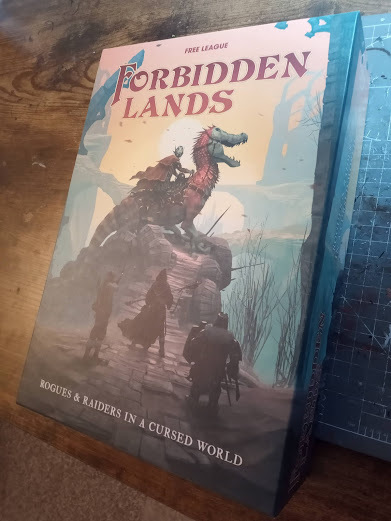
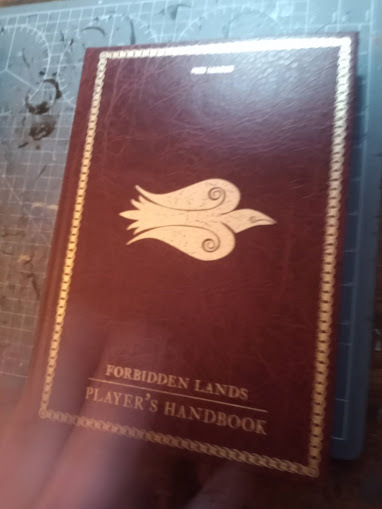
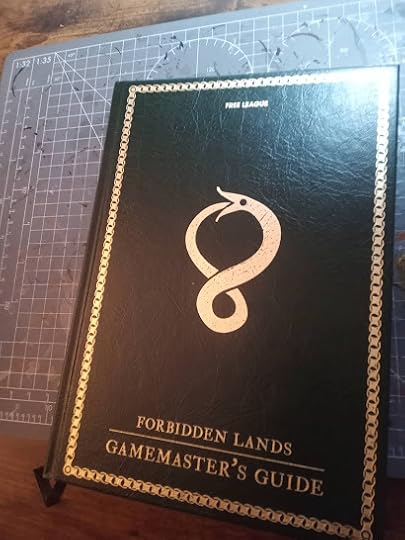
Forbidden Lands the full box et, untouched with the map with the stickers included. Before there was Mork Borg there was this.

But now there is Mork Borg, here is the fancy black edition from the Kickstarter. I actually had no idea this would be this popular. holy shit.
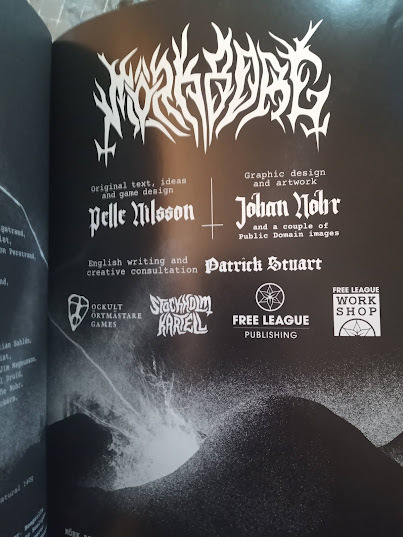
But I did do a bit of writing for it and am in the credits so if you want it signed I can do that.
Useful table below!
I have been putting together 'Bones of Bukako', the new revised and updated version of 'Feast of Bukako', the ever-growing tome of leveless spells based on inspiration from the False Machine catalogue, and in doing so I assembled this table as an aid.
The time intervals are based on the rate of increase in total spell levels in a standard BX Magic-User, rounded and then expressed in natural language. I'm using including this in the new version and including it as a potentially useful tool for DMs to judge how long Leveless Spells should last based on the levels of the caster.
Mage Level
Short Time (rounds, combat)
Medium Time (turns, exploration)
Long Time
(hours, days)
Very Long Time (curses, transformations)
Ritual Time Required (summoning etc)
1
1 Round
1 Turn
1 Hour
1 Day
12 Hours
2
2 Rounds
2 Turns
2 Hours
1 Day
11 Hours
3
4 Rounds
4 Turns
4 Hours
2 Days
10 Hours
4
6 Rounds
1 Hour
6 Hours
3 Days
8 Hours
5
1 Minute
1.5 Hours
9 Hours
5 Days
7 Hours
6
1 Minute
2 Hours
12 Hours
6 Days
5 Hours
7
2 Minutes
3 Hours
1 Day
9 Days
4 Hours
8
2 Minutes
4 Hours
1 Day
12 Days
3 Hours
9
3 Minutes
5 Hours
1 Day
16 Days
2 Hours
10
4 Minutes
7 Hours
2 Days
20 Days
1.5 Hours
11
5 Minutes
8 Hours
2 Days
24 Days
1 Hour
12
6 Minutes
10 Hours
2 Days
30 Days
4 Turns
13
7 Minutes
11 Hours
3 Days
35 Days
2 Turns
14
7 Minutes
12 Hours
3 Days
37 Days
1 Turn
April 24, 2022
Summer Wars
A war conflict on an epic scale, fought between city states, great wizards towers and strange underground races, with the occasional interruption of gargantuan kaiju-dragons and inexplicable chthonic entities
Aesthetic would be Elrics Melinbone in fineness but in colour and form, more like 19th century and later Fairy images - very bright, summery, decadent. A high-toned luxurious and sensual society of nobles, plus Warhammer, plus Honey I Shrunk the Kids
its a Wizards garden and the PCs are hired to sort out its infestation problem before summer ends, this means they get shrunk to micro-scale, and that leads to this ballardian dreamscape ruined plant arcology where grains of soil are like small hills, daisies are forts and daffodils are huge city-states
Fae queens riding flitterflies, flea-cavalry, infantry slogging through nightmare three-dimensional mazes being hunted by centipedes, war without end as the apex culture of a race of fae sorcerers blast each other with desolating magics and entrap each other in schemes - high intensity warfare and court drama with the PCs mixed up in the middle of it all.
THE GREEN TOWERS
War in a cool green cathedral shaped by vast leaves like towers of glass. A sylph queen garbed in armour of plated butterfly scales gazes down as an army musters outside her gates. The armour of a green knight expands into a chrysalis - what emerges is a sorcerer. Winter isn't just a season but the end of the world, and the rule of worms.
What is the sun but a green-gold glow that fills the air and in sliver gaps between towers, a blazing radiance which scorches and destroys.
What is night but a black riot of sounds, the grumbling of worms in the earth and the squealing of moths as they pass far above? What is a dragon but a being so vast its claw can crush the towers of the highest mage, armoured in great sweeps of scales themselves larger than many cities, a spear so mighty that it can plunge deep into the earth, deeper than the deepest mine, and pull forth entire, one of the great worms, and carry it off into the sky. A war of gods and monsters.
INVESTIGATION
A world at this small, very small, microverse, would need more actual research than is customarily assumed. The classic post-fairy-tale paracosms, Honey I Shrunk the Kids, the Marvel and DC shrinking heroes etc, tend to work at a scale at which the very small to us becomes very big to them (Godzilla battles a single rat in the New York sewers etc), but at this very micro microverse, what is small to us becomes nearly insensible to them. A thrush, not just a monster but a Behemoth of god, and what is nearly microscopically indistinguishable to us becomes the material of life to them.
How does reality work at this scale and how much blurring into dreamland should we engage in?
Gravity and oxygen for a start, will be very different. For a being this small climbing would not be hard.
What are they breathing? Are they breathing like we do or are they fundamentally different beings only seemingly related to our world, like parallel reality creatures existing at this low scale? Like ghosts or the flickering spirts of dreams sparking into corporeality for one long summer.
And I would need to look into the substances of the microverse, at the scale at which an ant is like a giant war elephant or something, what is a sword made of? What are people drinking? Are they burrowing into the surface tension of water droplets like miners with asteroids?
Are you chilling with a tardigrade? Do you snort RNA like its a drug?
If I remember my microverse properly, its a realm of scent as much as sight. The wind doesn't even reach down here, fogs and clouds of pheromones drift opalescent through the still air, to us it would be like a second texture to the air itself, tinting and ruffling, though not necessarily obscuring. Pollen whirling through the air like cartwheels. A poisoned blade drawn from the stinger of a nettle.
The land of the dead cannot be very far away, its down where the roots go, beneath the stones. The land is not level, it is built up of great jagged boulders of soil, each one independently alive, and there are cracks between them always, it only needs a slip and down you go into the lightless depths to be hunted by skittering centipedes. The earth quakes and churns with the movements of the great worms beneath it. A mosquito is a vampire dragon which, every hundred days, feeds upon he blood of great forgotten gods.
THE WARS OF THE PETAL-DWELLERS
The armies of the petal-dwellers marching forth in great crumbling lines, shining like droplets holding high banners made from the tuft hairs of baby moles, of single fish scales, blowing strange trumpets carved from the earbones of shrews. Ant-mahouts perfume the air to drag forth huge false-caterpillars; siege engines built from the root tendrils of holly plants. From where will assault come? From above as strike teams ride huge ladybirds in assault? From below as bind sappers tunnel forth under your very feet on the backs of ants? From around as tick-riders encircle the column? Spotters riding preserved dandelion seeds tied to lumbering beetles by spiderweb try to observe but they are little use. A long trek to assault the plant stem of another petal-dwelling lord or lady.
And all for what? A word.. or a glance. A bet or sharp look over the turning of a card made from the dried cornea of a baby mouse. What else is there for a noble to do but to marshal forces and send forth great powers to crawl through leagues of hellish nightmare, rolling dice of crystal quartz* with every turn and pathway, only to assault a green tower, climb its rugose column, hack at its roots, inject troops into its capillaries and in the end a daisy falls in the night, a culture annihilated, its pollen given to the wind and petals fallen to the realm of death to be carried away by pale ants.
(*crystal being maybe the only substance which would look, feel and largely act the same way in the microverse)
April 11, 2022
Interview with Noisms about "Hall of the Third Blue Wizard"
The Kickstarter - https://www.kickstarter.com/projects/thirdbluewizard/in-the-hall-of-the-third-blue-wizard
Davids Blog - http://monstersandmanuals.blogspot.com/
Matthew Adams Art for new Yoon-Suin - http://monstersandmanuals.blogspot.com/2021/06/yoon-suin-2nd-edition-art-update.html
John Martins 'The Bard' - https://commons.wikimedia.org/wiki/File:The_Bard.jpg
David on Russian Classical Music - http://monstersandmanuals.blogspot.com/2022/03/russian-inspiration.html
Rachmaninoffs Vespers - https://www.youtube.com/watch?v=U2NSfTXjEPI&t=179s
Matthew Adams left this comment on Facebook; "Ha, now I can tell mum and dad I am a genius!
But also, the look of concern on your face Patrick when you looked at the yoon suin art. Please forgive me! Though I admit I did laugh a little bit because I was expecting it. And you are not the only one to express concern or even dislike of my MS paint art.
David is mostly right about why I am doing a lot of my art in MS Paint and other old digital formats like PETScii. I enjoy working within the constraints those programs enforce, and there might be some nostalgia there as well. But there is also an element of burnout involved. A few years ago, just before the end of g+ really, the whole process of drawing on paper started to make me almost physically sick. I don't know why. Depression, anxiety, doubt, all played a part, and maybe something wasn't clicking creativity wise. But for quite a while the act of putting pen or pencil to paper was enough to make me vomit. Now I am doing more analogue drawing again, but it's usually within the constraint of designing rubber stamps."
April 8, 2022
Paint Yourop, Draw Yndja
Other cultures, what even do they look like. A question for academics. Here in the Mughals Painting workshop (about 1500), and the German Print Shop (early 20thC), we are on a deadline people! The Mughal says "Draw Youropeen", Herr Schvitz say "Draw Indian God for export schnell!" What goes in the background? Yourpeen things, Ynjan things I don't know just finish the fucking picture!
We start with whats honestly a pretty great painting of a foreigner from the Mughals court (I think Akbar? Dunno and I'm not checking).
Youropeen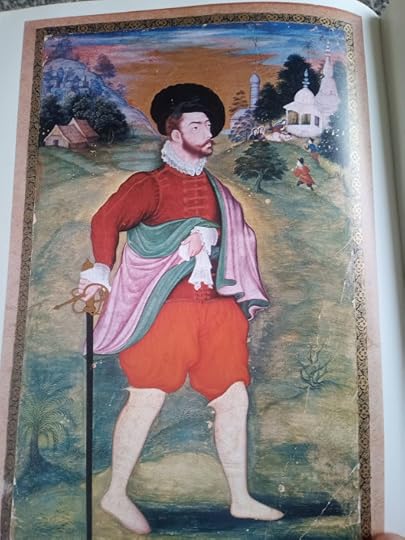
But whats happening here in the background of this very Youropeen landscape?
Youropeen plant
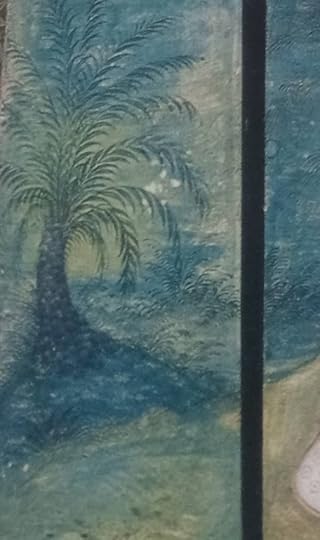
And where do Youropeens live? Hut or possibly city...
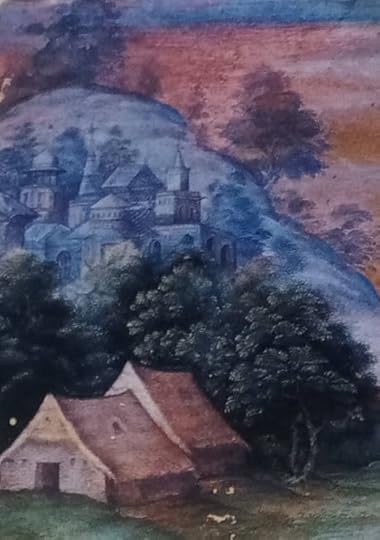 (Honestly not bad for 1500 or so)
(Honestly not bad for 1500 or so)How do they worship? Ehhhh hmm temples?
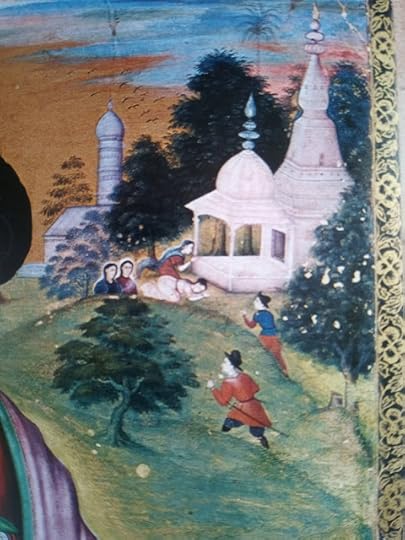
"Here we go worshipping christ again! As we commonly do here in Yourop!"
Meanwhile, (in fact several hundred years later), Germany leads der printing welt! Time to impinge on British Raj mit VORGESETZTER prints of Indian Gods for popular market! Quick, draw Vishnu!
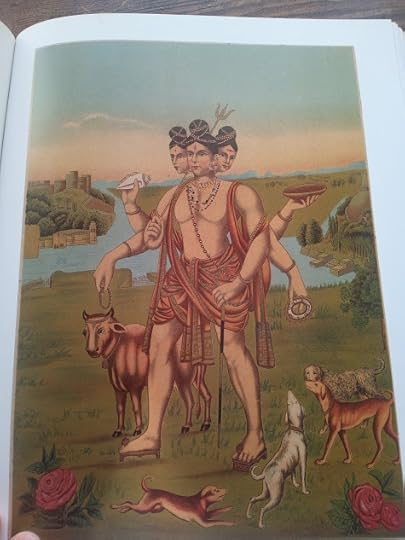 Not that bad? A bit stiff and euro-saintlike but wait, what is India even like anyway?
Not that bad? A bit stiff and euro-saintlike but wait, what is India even like anyway?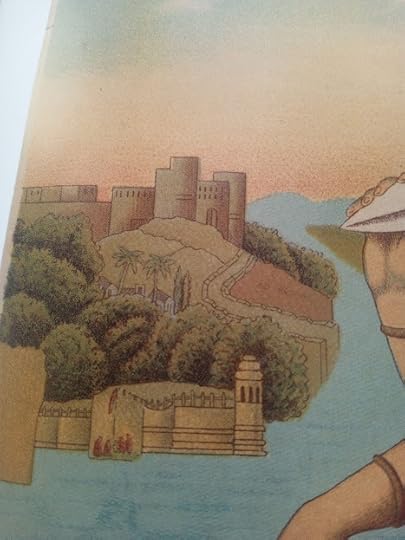
They have.. der schloss?
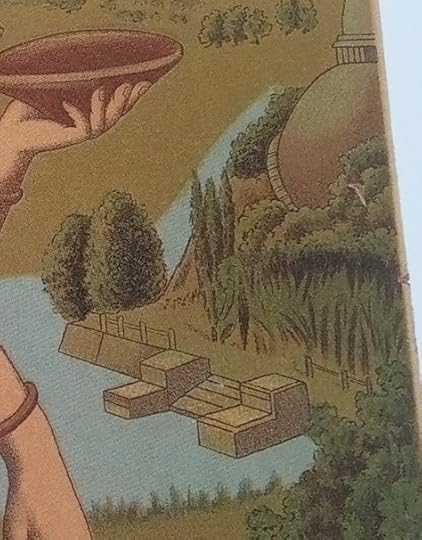 Aaaand... seltsame runde Dinge, vielleicht ist es ein Dock, ich weiß es nicht
Aaaand... seltsame runde Dinge, vielleicht ist es ein Dock, ich weiß es nichtNever mind, draw Krishna!
Krishna with his Gopis
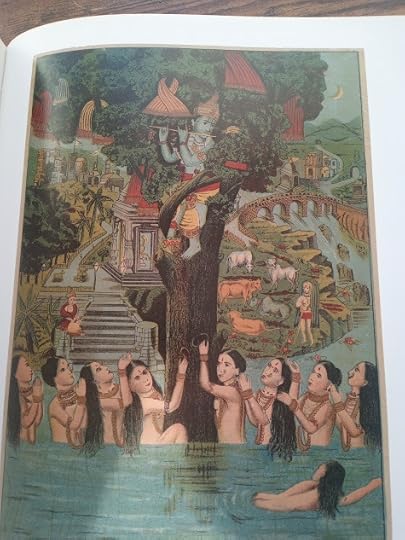
Perfect! Now eine Stadt in den Hintergrund schieben oder so
what do Ynjan cities look like?
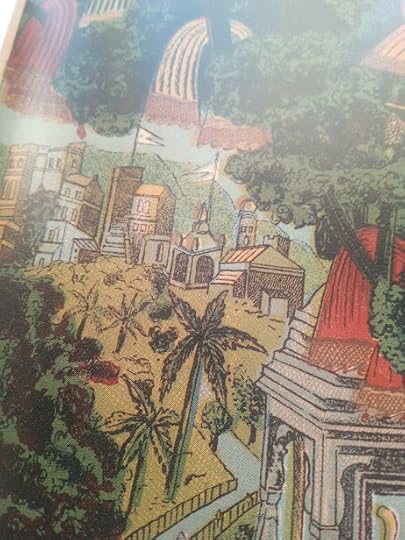
Vvvvenice? Kind of?
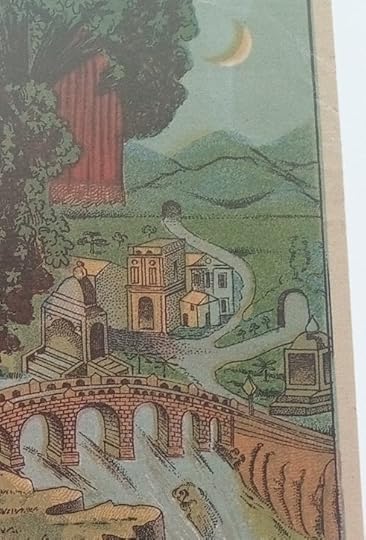
and uh.. gebäude.. setzt...


